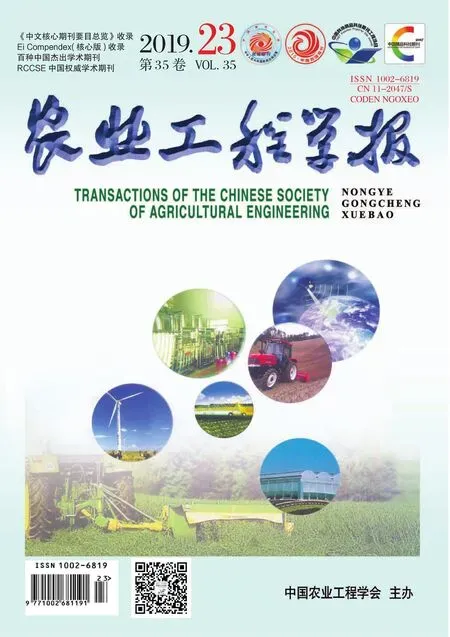基于无人机数码影像和高光谱数据的冬小麦产量估算对比
2019-02-20陶惠林冯海宽杨贵军杨小冬苗梦珂吴智超翟丽婷
陶惠林,冯海宽,杨贵军,杨小冬,苗梦珂,5,吴智超,5,翟丽婷,5
基于无人机数码影像和高光谱数据的冬小麦产量估算对比
陶惠林1,2,3,4,冯海宽1,3,4※,杨贵军1,3,4,杨小冬1,3,4,苗梦珂1,3,4,5,吴智超1,3,4,5,翟丽婷1,3,4,5
(1. 农业农村部农业遥感机理与定量遥感重点实验室,北京农业信息技术研究中心,北京 100097; 2. 安徽理工大学测绘学院,淮南 232001; 3. 国家农业信息化工程技术研究中心,北京 100097; 4. 北京市农业物联网工程技术研究中心,北京 100097;5. 河南理工大学测绘与国土信息工程学院,焦作 454000)
作物产量准确估算在农业生产中具有重要意义。该文利用无人机获取冬小麦挑旗期、开花期和灌浆期数码影像和高光谱数据,并实测产量。首先利用无人机数码影像和高光谱数据分别提取数码影像指数和光谱参数,然后将数码影像指数和光谱参数与冬小麦产量作相关性分析,挑选出相关性较好的9个指数和参数,最后以选取的数码影像指数和光谱参数为建模因子,通过MLR(multiple linear regression,MLR)和RF(random forest,RF)对产量进行估算。结果表明:数码影像指数和光谱参数与实测产量均有很强的相关性。利用数码影像指数和光谱参数通过MLR和RF构建的产量估算模型均在灌浆期表现精度最高,在灌浆期,数码影像指数和光谱参数构建的MLR模型2和NRMSE分别为0.71、12.79%,0.77、10.32%。对模型对比分析可知,以光谱参数为因子的MLR模型精度较高,更适合用于估算冬小麦产量。利用无人机遥感数据,通过光谱参数建立的MLR模型能够快速、方便地对作物进行产量预测,并可以根据不同生育期的产量估算模型有效地对作物进行监测。
无人机;数码影像;高光谱;冬小麦;产量;估算;多元线性回归;随机森林
0 引 言
在精准农业中,作物产量的准确监测对农业管理方面有着重要的意义[1-3]。通过卫星可以实现大范围、大区域监测[4]。而对于小尺度作物的监测,由于卫星数据获取时间长,受分辨率和气象等多方面影响,所体现的作用不明显[5-6]。无人机遥感具有较高的分辨率,操作便捷,能够快速地进行观测[7-10],相比卫星受限制条件少,在田间对作物进行监测能够取得很好的效果。估算作物产量方面,根据平台的不同,所获取数据的方式各异,如利用卫星、无人机或地面获取。国内外学者在作物产量估算方面做了大量研究,何亚娟等[11]根据SPOT卫星遥感数据通过甘蔗的叶面积指数(leaf area index,LAI)对甘蔗的产量进行了估算,并构建LAI-产量估算模型取得较好效果。朱婉雪等[12]利用无人机对冬小麦的3个生育期进行了观测,通过最小二乘分析方法建立不同植被指数的产量估算模型,各指数构建的冬小麦估算模型中在灌浆期建模模型的效果最好,指数EVI2(enhanced vegetation index without a blue band,EVI2)建立的模型精度最高。Kefauver等[13]利用无人机RGB、多光谱、热航空影像数据,多影像组合数据构建的多元线性模型可以对大麦产量进行有效估算。Mengmeng等[14]利用低空无人机图像数据得到的9种植被指数构建了逐步回归模型,表明小麦产量与可见带差异植被指数、归一化绿-蓝差异指数、绿-红比率指数和绿色植被指数相关。Gong等[15]通过无人机遥感数据,探究出归一化差异植被指数能够很好地对产量进行估算,估算的误差小于13%。刘焕军等[16]用航空高光谱数据,研究出通过光谱一阶微分参数构建的产量预测模型精度优于以归一化植被指数、优化土壤调节植被指数和二阶微分构建的估产模型。吴琼等[17]利用地面高光谱数据,验证出多生育期的估测效果优于单个生育期。张松等[18]基于地面高光谱遥感数据将植被指数作为构建产量估算模型的因子,构建的估算模型孕穗期和抽穗期的精度较高,能够很好地监测冬小麦产量。以上研究从不同数据获取方式,不同分析方法等方面估算作物产量,但利用无人机数码和高光谱数据估算作物产量并进行对比精度分析的研究还很少。本文通过无人机遥感平台,利用无人机数码与高光谱数据分别估算冬小麦产量,以数码影像指数和光谱参数为建模因子,通过机器学习多元线性回归(MLR)和随机森林(RF)2种方法分别构建了基于无人机数码和高光谱的冬小麦产量估算模型,探讨2种遥感数据的估算精度、最优模型和最佳估算生育期。本研究提供了一种基于无人机遥感平台的科学技术方法,以便农业管理者更好地监测作物产量。
1 材料与方法
1.1 研究区概况与试验设计
试验所在地位于北京市昌平区小汤山镇国家精准农业研究示范基地,处温榆河冲积平原和燕山、太行山支脉的结合地带,地理坐标为40°00′~40°21′N,116°34′~117°00′E,在温带季风区,属暖温带大陆性季风气候,地势平坦,土壤肥沃,多种植小麦、玉米等,研究区位置如图1所示。

图1 研究区位置
此次试验在示范基地的田间进行,试验田东西总长度为84 m,南北总长度为32 m,在冬小麦品种方面,选用了京9843(P1)和中麦175(P2)2个品种;在施肥肥料方面,不同类型处理的尿素施肥量分别为N1(不施用)、N2(195 kg/hm2)、N3(390 kg/hm2)和N4(585 kg/hm2);水分处理方面分别为W1(雨养)、W2(正常水,675 m3/hm2)和W3(1.5倍正常水,1 012.5 m3/hm2)3种方式处理。该试验田16个小区,3次重复处理,并在不同时期进行监测,分别进行了3个不同生育期试验,试验田分布如图2所示。
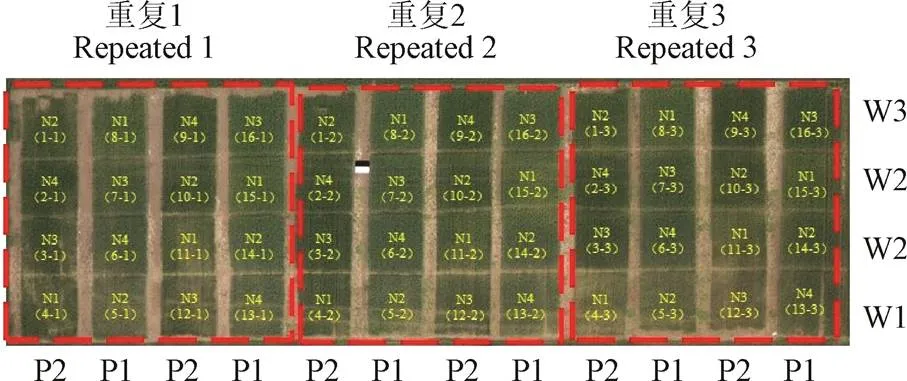
注:P是冬小麦品种,P1:京9843,P2: 中麦175;W是水分处理,W1、W2、W3分别为雨养、675、1 012.5 m3·hm-2;N为尿素施用,N1、N2、N3、N4分别为 0、195、390和585 kg·hm-2。
1.2 数据获取及处理
1.2.1 地面数据获取与处理
在冬小麦的成熟后,在每个试验小区随机取1 m2区域进行调查,通过收获1 m2的籽粒并折算成14%含水率下的产量计算实测产量,共获得48个小区的产量数据。
1.2.2 无人机数码影像与高光谱数据获取与处理
本次试验采用了八旋翼无人机,机身净质量4.2 kg,载物质量6 kg,单臂长386 mm,续航时间15~20 min,无人机获取数据时要求天气晴朗少云,时间在 10:00-14:00之间,飞行高度为80 m,携带的传感器是数码相机和成像光谱仪,其主要参数如表1所示,获取的影像见图3。分别在冬小麦的挑旗期(2015年4月26号)、开花期(5月13号)、灌浆期(5月22号)3个不同生育期进行数码和高光谱影像数据获取。
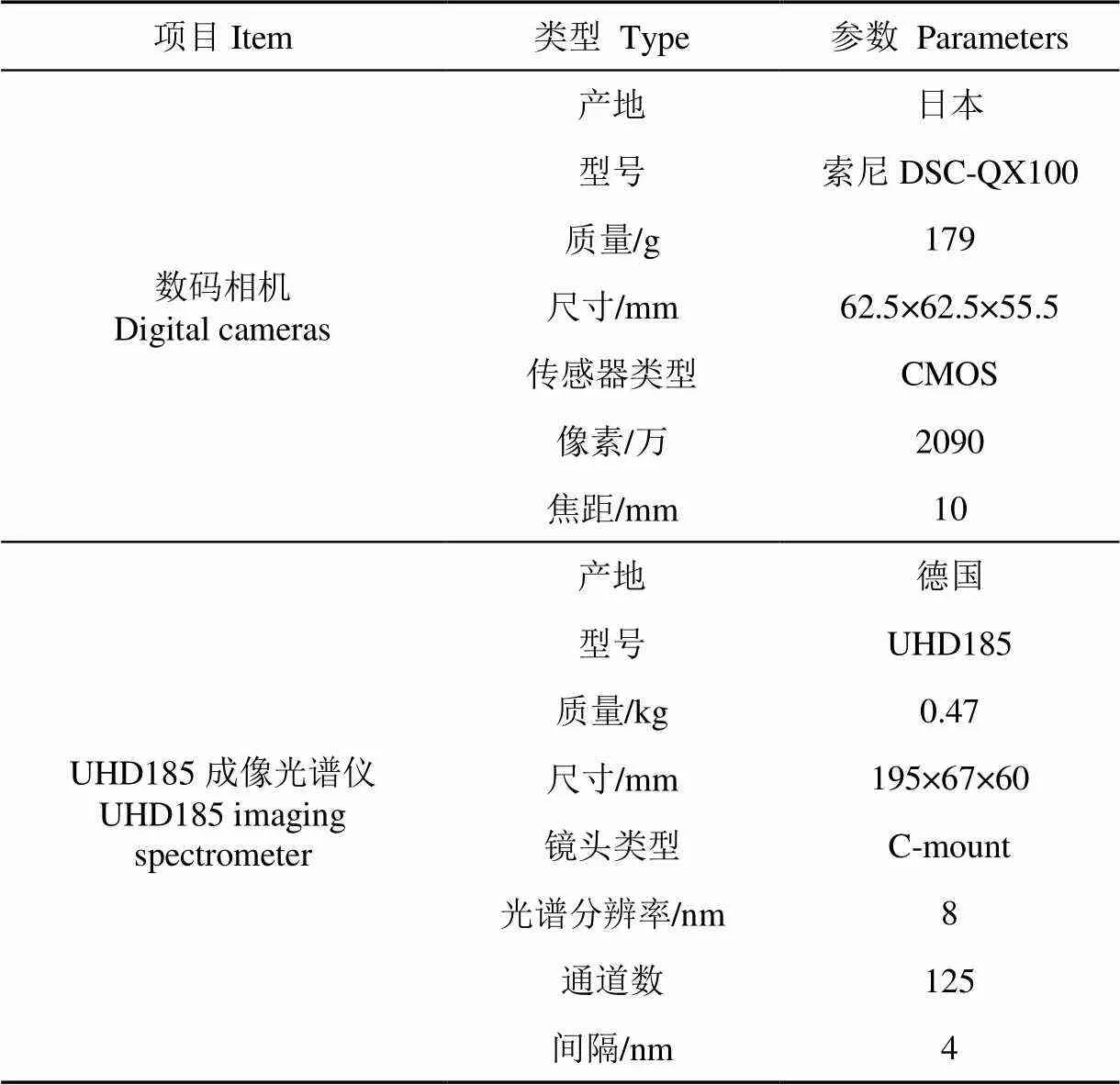
表1 数码相机和UHD185成像光谱仪的主要参数
无人机数码影像处理主要利用俄罗斯Agisoft LLC公司的Agisoft PhotoScan Professional软件进行影像拼接处理,过程如下:1)将无人机数码影像和飞行时的位置和姿态数据导入;2)生成密集点云;3)建立网格;4)生成空间纹理;5)生成冬小麦材料的无人机数码高清正射影像。
无人机高光谱数据进行处理过程具体如下:
1)无人机高光谱影像校正和拼接。对于影像的校正,需要把无人机高光谱影像遥感影像像元亮度值DN(digital number,DN)值转化为地表反射率,在进行影像拼接处理的时候借鉴Turner等[19]的研究成果,将获取的影像和位置数据,利用UHD185自带的处理软件和俄罗斯Agisoft LLC公司的Agisoft PhotoScan 软件进行影像拼接,经过影像的校正和拼接生成了挑旗期、开花期和灌浆期的高光谱正射影像,每个生育期的影像中有125个波段,每个波段间隔4 nm,波段范围为454~950 nm。
2)提取光谱反射率。在进行反射率提取时,为了更好地控制区域矢量问题,过程主要在Arcgis软件中完成,在软件中根据每个小区的面积绘制出30个矢量,每个小区编号,绘制出的矢量面积总和等于每个小区的矢量面积,每个生育期影像有48个小区,得到1 440个矢量数据,再通过IDL程序对应小区编号计算出每个小区的光谱反射率的平均值,并以平均值为该小区的光谱反射率,获取不同生育期的各小区光谱反射率。
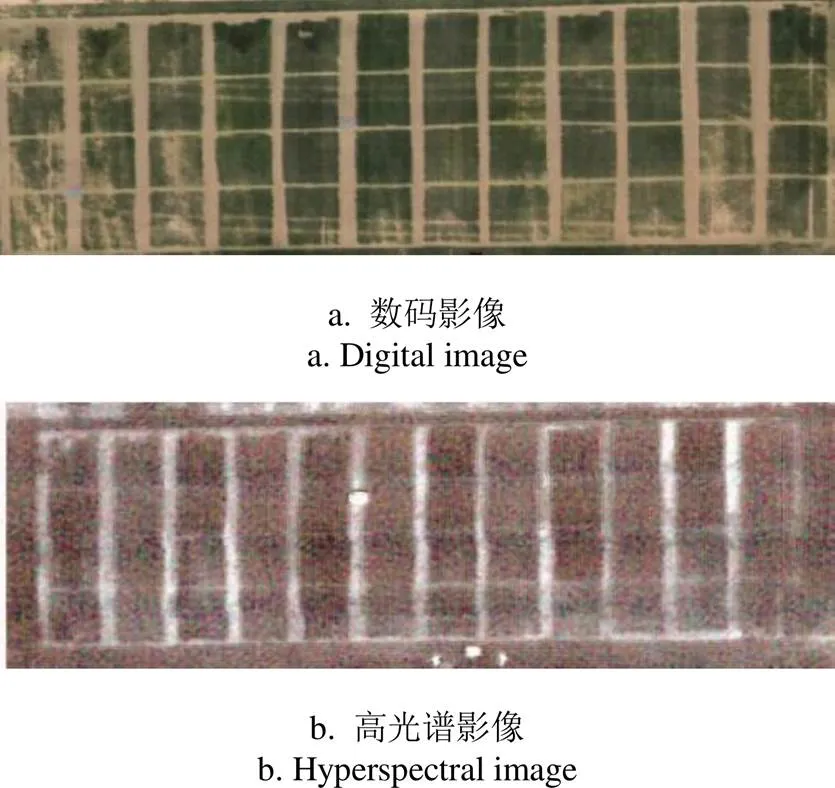
图3 无人机数码和高光谱影像
1.3 研究方法
1.3.1冬小麦估算模型
本文选取了多元线性回归(multiple linear regression,MLR)和随机森林(random forest,RF)2种分析方法,分别建立不同植被指数与冬小麦产量的估算模型,模型为常用的统计模型,MLR使用的前提是自变量和因变量有着很好的相关性,能够通过多个自变量来预测因变量。 RF的算法是基于bootstrap取样的一种机器学习算法,通过将样本放回抽样的方法进行多次取样,建立决策树模型,进行决策树组合预测,分类效果越好,说明构建的模型精度越高。
1.3.2 数码影像指数选取
利用生成的无人机数码高清正射影像,绿色植物反射绿光和吸收红和蓝光的特征,从数码高清正射影像中提取出冬小麦试验田各小区的DN值,将影像中的红、绿、蓝光这3个通道的DN值进行归一化处理,得到、、,计算公式见表2。
根据前人的研究成果,选取11种植被指数,加上红绿蓝以及归一化后的数码影像指数,总共17个数码影像指数,用来对冬小麦的产量进行估算研究,具体如表2所示。
1.3.3 光谱参数选取
植被指数被广泛应用于农业作物监测,本文根据前人的研究成果,选择8个典型的高光谱植被指数。另外Aasen等[27]发现红边区域波段可以有效监测作物长势,故文中挑选了4个红边参数,具体光谱参数如表3所示。
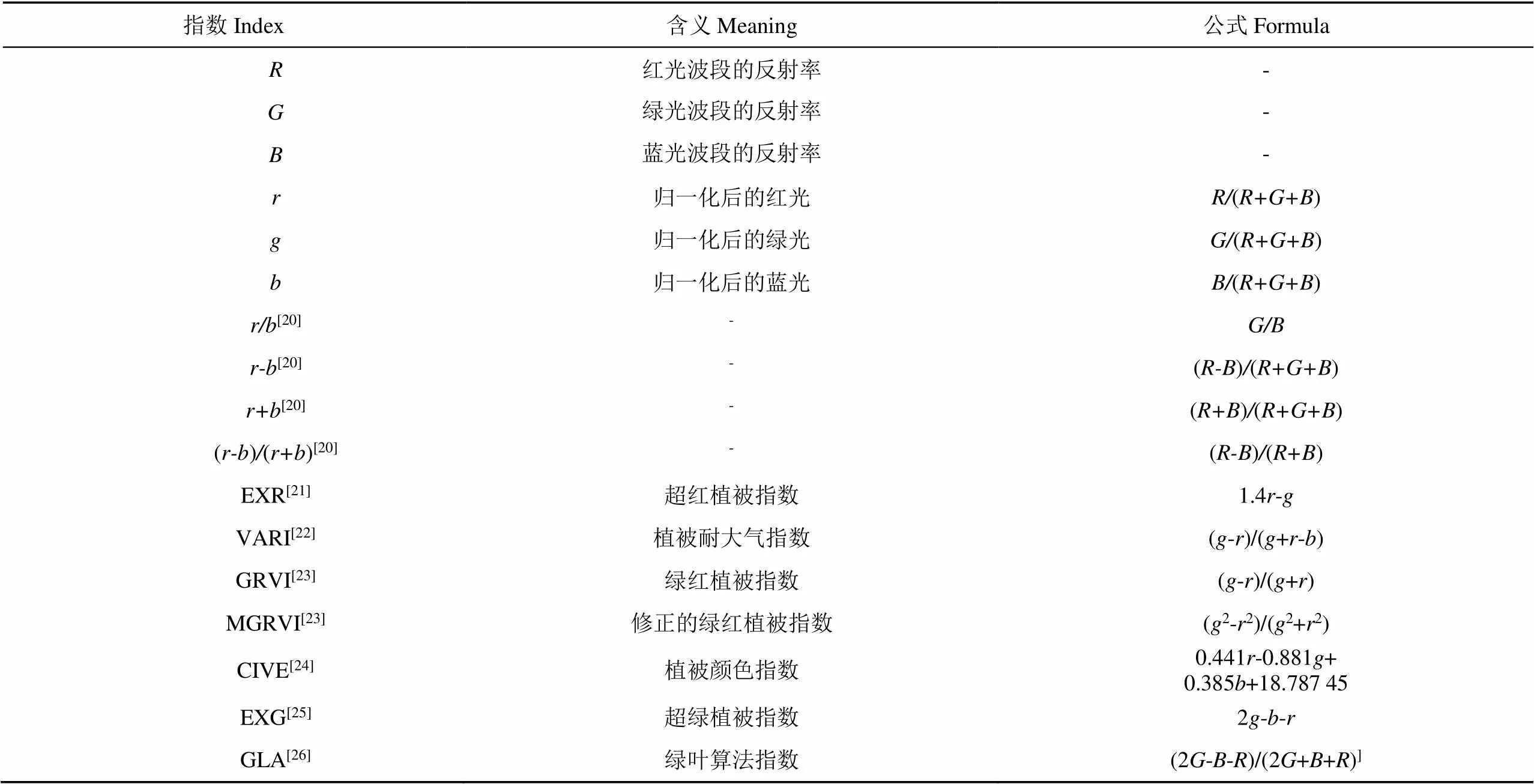
表2 数码影像指数

表3 光谱参数
1.3.4 模型精度验证
文中根据冬小麦产量估算模型的构建,选取决定系数(coefficient of determination,2)、均方根误差(root mean squared error,RMSE)和标准均方根误差(normalized root mean squared error,NRMSE)3个指标作为模型精度的验证。
2 结果与分析
2.1 无人机数码影像指数和光谱参数与产量的相关性分析
将数码影像指数和光谱参数与冬小麦实测产量数据进行相关性分析,结果见表4。

表4 无人机数码影像指数和光谱参数与冬小麦实测产量相关性分析
注:*表示在0.05水平上显著,**表示在0.01水平上显著。
Note:*represents significant at 0.05 level, ** represents significant at 0.01 level.
从表4中可知,数码影像指数与冬小麦实测产量均呈现极显著相关(<0.01);光谱参数和冬小麦实测产量相关性大部分也达到极显著水平。相比不同生育期,挑旗期的无人机数码影像指数均与冬小麦实测产量呈现极显著相关,其中指数的相关系数绝对值最大,为0.671;而光谱参数中,除光谱参数红边振幅表现显著相关外,剩余的参数均表现出极显著水平,相关性最好的是TCARI/OSAVI,相关系数为0.744;开花期,数码影像指数与实测产量相关性均表现出极显著相关,指数的相关性系数绝对值最大,为0.737;光谱参数中TCARI和最小振幅表现无显著相关,其余的光谱参数都表现出极显著相关,其中表现效果最好的是参数SR,相关系数是0.795;灌浆期,数码影像指数与实测产量相关性均极显著相关,相关性绝对值最高的指数为,为0.747;对于光谱参数而言,仅TCARI无显著相关,其余参数均极显著相关,表现最好的参数是TCARI/OSAVI,相关系数达到0.800。
2.2 基于无人机数码影像数据的冬小麦产量估算精度分析和验证
根据无人机数码影像指数与冬小麦产量相关性分析结果,按相关性强弱,在不同的生育期和利用高光谱数据估算产量一样分别挑选出9个相关系数较大的数码影像指数,选取的数码影像指数作为冬小麦产量估算模型的因子通过MLR和RF来构建模型,得到了挑旗期、开花期与灌浆期的MLR和RF模型的各评价指标,结果如表5所示。

表5 建模集不同生育期的数码影像指数估算冬小麦产量的精度分析
根据表5,MLR模型的精度在不同生育期均明显优于RF模型,且2种模型的估算精度均表现为灌浆期最高,挑旗期最低。其中MLR模型最佳2是0.71(RMSE=730.66kg/hm2,NRMSE=12.79%),RF模型最佳2是0.57(RMSE=894.16kg/hm2,NRMSE=15.65%),说明MLR模型优势较为明显。
分别对冬小麦的3个生育期构建的产量估算模型进行验证,获得不同生育期的验证分析结果,见图4和图5。MLR和RF模型验证的估算效果和建模效果保持一致,从挑旗期到灌浆期,MLR和RF模型均表现效果逐渐增强,至灌浆期,达到最佳,MLR和RF验证2分别是0.77、0.52,NRMSE分别达到13.56%、17.22%,验证效果较好。

图4 验证集数码影像的MLR方法预测产量与实测产量对比

图5 验证集数码影像的RF方法预测产量与实测产量对比
2.3 基于无人机高光谱数据的冬小麦产量估算精度分析和验证
利用建模分析方法MLR和RF构建冬小麦挑旗期、开花期、和灌浆期的产量估算模型,根据光谱参数的相关性分析结果,挑选出相关性绝对值较大的前9个光谱参数作为估算冬小麦产量的自变量,保证了自变量中同时包含植被指数和红边参数。挑旗期、开花期和灌浆期取重复1和重复2区域数据,共32个样本作建模集,结果如表6所示。
从表6可知,从挑旗期到灌浆期,对于MLR和RF模型,模型的估算精度逐渐提高,拟合效果越来越好,其中MLR模型最佳2是0.77,NRMSE是10.32%;RF模型最佳2是0.61,NRMSE是14.79%,MLR模型估算精度在不同生育期均优于RF模型。
为了验证建模集估算效果,将重复3区域数据(16个样本)进行模型验证,结果见图6和图7。随着生育期推移,验证集2逐渐增大,RMSE和NRMSE逐渐减小,结果与建模集效果保持一致,说明验证的效果比较稳定。另外,与数码影像指数估算的结果一致,MLR和RF模型验证精度也是灌浆期最高,开花期次之,挑旗期精度最低。

表6 建模集不同生育期的光谱参数估算冬小麦产量的精度分析

图6 验证集高光谱数据的MLR方法预测产量与实测产量对比

图7 验证集高光谱数据的RF方法预测产量与实测产量对比
2.4 精度对比
分别利用无人机数码和高光谱影像数据对冬小麦产量进行估算,构建了基于2种遥感数据的冬小麦不同生育期的MLR和RF模型。利用相同方法,不同数据构建产量估算模型,基于无人机高光谱数据构建的产量模型效果均优于基于无人机数码数据的模型,通过无人机高光谱和无人机数码构建的最优模型建模2分别为0.77、0.71,RMSE分别646.67 kg/hm2、730.66 kg/hm2,NRMSE分别为10.32%、12.79%。对比不同方法建立的2种估算模型,相同数据下MLR构建的模型优于RF模型。基于无人机数码影像构建的MLR与RF模型挑旗期2分别为0.48、0.24,NRMSE分别为17.24%,21.60%;开花期2分别是0.69、0.56,NRMSE分别为13.18%、 15.85%;灌浆期2分别为0.71、0.57,NRMSE分别为12.79%、15.65%。基于无人机高光谱数据构建的MLR与RF挑旗期2、NRMSE分别为0.64、14.33%,0.37、19.01%,开花期2、NRMSE分别是0.75、11.10%,0.58、15.37%,灌浆期2、NRMSE分别为0.77、10.32%,0.61、14.79%。综合模型的评价指标和模型的适用性,MLR方法模型更适合产量估算,且利用无人机高光谱数据估算产量效果较好。
3 讨 论
人工估产所进行的工作量大、过程繁琐且很容易受到人为和其他因素的干扰。从而影响估算精度,利用无人机数码影像和高光谱数据进行估算可以避免这些问题。数码相机和高光谱的空间分辨率较高,在进行取样时所取的大小为1 m2,区域内冬小麦的生长较为一致,数据具有代表性,然后在通过无人机数码影像和高光谱数据进行产量估算。
所选取的数码影像指数和光谱参数大部分都与冬小麦产量呈现极显著相关(<0.01),在冬小麦不同生育期,数码影像指数与光谱参数和产量相关性存在差异,这与不同生育期时波段敏感程度有关,挑旗期,波段敏感性不强,数码影像指数和光谱参数的相关性绝对值较小,随着冬小麦生长,开花期和灌浆期波段敏感性逐渐增强,与产量相关性绝对值逐渐变大,因此,数码影像指数与光谱参数均与小麦产量有着较好的相关性。总体来说,小麦产量与灌浆期相关性最好,开花期其次,而挑旗期最差。
将数码影像指数和光谱参数通过MLR和RF方法进行冬小麦产量估算,发现在不同时期模型的效果不同,模型精度最高的时期是灌浆期,精度最差的是挑旗期。从拟合性、一致性和精度来看,MLR模型效果均强于RF模型,模型精度表现为灌浆期高于开花期,开花期高于挑旗期,2种模型的估算结果和冬小麦生长规律较为一致,随着生育期推移,越靠近生育期后期冬小麦的产量越趋于稳定,而此时进行估算的产量结果能够很好地反映冬小麦的实测产量,所以在灌浆期构建冬小麦产量估算模型效果是最好的。
尽管数据源不同,但建立的估算模型均表现出模型MLR精度高于RF,这是由于RF适合数据较多的样本,在样本量少的情况下表现波动。另外,相比数码相机,高光谱数据分辨率高,波段较多,能够较全面地反映冬小麦信息,综合来说,通过MLR方法以光谱参数为因子的估算模型较优。
估产过程中受土壤背景和阴影光谱的影响[12],直接通过单个植被指数估算产量,而不考虑不同生长期光谱影响,估产模型适用性不高[18]。另外,利用无人机数码和高光谱估产,可以对比不同传感器的估产性能,以便选取更合适的估产方式。冬小麦不同生长期光谱受影响大小不同,如何更好地利用植被指数消除外界因素干扰提高估产精度,需要进一步研究。另外,本文仅利用一年冬小麦数据分析,未来将针对长时间序列数据进行深入研究。
4 结 论
本文基于无人机数码影像和高光谱数据对不同生育期冬小麦产量进行估算,研究结论如下:
针对不同生育期的数码影像指数和光谱参数,模型MLR拟合性和精度均高于RF。就生育期而言,表现最好的均是灌浆期,基于光谱参数的MLR模型2、RMSE和NRMSE分别为0.77、646.67 kg/hm2、10.32%,RF模型的2、RMSE和NRMSE分别是0.61、838.99kg/hm2、14.79%;基于数码影像指数的MLR模型2、RMSE和NRMSE分别是0.71、730.66kg/hm2、12.79%,而RF模型分别为0.57,894.16kg/hm2,15.65%。
[1] 任建强,陈仲新,唐华俊,等. 基于遥感信息与作物生长模型的区域作物单产模拟[J]. 农业工程学报,2011,27(8):257-264.
Ren Jianqiang, Chen Zhongxin, Tang Huajun, et al.Regional crop yield simulation based on crop growth model and remote sensing data[J]. Transactions of the Chinese Society of Agricultural Engineering (Transactions of the CSAE), 2011, 27(8): 257-264. (in Chinese with English abstract)
[2] Mueller N D, Gerber J S, Johnston M, et al. Closing yield gaps through nutrient and water management[J]. Nature, 2012, 490(7419): 254-257.
[3] Neumann K, Verburg P H, Stehfest E , et al. The yield gap of global grain production: A spatial analysis[J]. Agricultural Systems, 2010, 103(5): 316-326.
[4] Du M, Noguchi N. Multi-temporal monitoring of wheat growth through correlation analysis of satellite images, unmanned aerial vehicle images with ground variable[J]. IFAC PapersOnLine, 2016, 49(16): 5-9.
[5] 苏伟,侯宁,李琪,等. 基于Sentinel-2遥感影像的玉米冠层叶面积指数反演[J]. 农业机械学报,2018,49(1):151-156.
Su Wei, Hou Ning, Li Qi, et al. Retrieving leaf area index of corn canopy based on sentinel-2 remote sensing image[J]. Transactions of the Chinese Society for Agricultural Machinery, 2018, 49(1): 151-156.(in Chinese with English abstract)
[6] Yu N, Li L, Schmitz N, et al. Development of methods to improve soybean yield estimation and predict plant maturity with an unmanned aerial vehicle based platform[J]. Remote Sensing of Environment, 2016(187): 91-101.
[7] 张春兰,杨贵军,李贺丽,等. 基于随机森林算法的冬小麦叶面积指数遥感反演研究[J]. 中国农业科学,2018,51(5):855-867.
Zhang Chunlan, Yang Guijun, Li Heli, et al.Remote sensing inversion of leaf area index of winter wheat based on random forest algorithm[J]. Scientia Agricultura Sinica, 2018, 51(5): 855-867. (in Chinese with English abstract)
[8] Yue Jibo, Feng Haikuan, Jin Xiuliang, et al. A comparison of crop parameters estimation using images from UAV-mounted snapshot hyperspectral sensor and high-defifinition digital camera[J]. Remote Sensing, 2018(10): 1138-1162.
[9] 常潇月,常庆瑞,王晓凡,等. 基于无人机高光谱影像玉米叶绿素含量估算[J]. 干旱地区农业研究,2019,37(1):66-73.
Chang Xiaoyue, Chang Qingrui, Wang Xiaofan, et al.Estimation of maize leaf chlorophyll contents based on UAV hyperspectral drone image[J]. Agricultural Research in the Arid Areas. 2019, 37(1): 66-73. (in Chinese with English abstract)
[10] Watanabe K, Guo W, Arai K, et al. High-throughput phenotyping of sorghum plant height using an unmanned aerial vehicle and its application to genomic prediction modeling[J]. Frontiers in Plant Science, 2017, 8:421-432.
[11] 何亚娟,潘学标,裴志远,等. 基于SPOT遥感数据的甘蔗叶面积指数反演和产量估算[J]. 农业机械学报,2013,44(5):226-231.
He Yajuan, Pan Xuebiao, Pei Zhiyuan, et al. Estimation of LAI and yield of sugarcane based on SPOT remote sensing data[J]. Transactions of the Chinese Society for Agricultural Machinery, 2013, 44(5): 226-231. (in Chinese with English abstract)
[12] 朱婉雪,李仕冀,张旭博,等. 基于无人机遥感植被指数优选的田块尺度冬小麦估产[J]. 农业工程学报,2018,34(11):78-86.
Zhu Wanxue, Li Shiji, Zhang Xubo, et al. Estimation of winter wheat yield using optimal vegetation indices from unmanned aerial vehicle remote sensing[J]. Transactions of the Chinese Society of Agricultural Engineering (Transactions of the CSAE), 2018, 34(11): 78-86. (in Chinese with English abstract)
[13] Kefauver S C, Vicente, Vergara-Díaz O, et al. Comparative UAV and field phenotyping to assess yield and nitrogen use efficiency in hybrid and conventional barley[J]. Frontiers in Plant Science, 2017, 8 : 1733-1748.
[14] Mengmeng D, Noboru N. Monitoring of wheat growth status and mapping of wheat yield’s within-field spatial variations using color images acquired from UAV-camera system[J]. Remote Sensing, 2017, 9(3): 289-303.
[15] Gong Yan, Duan Bo, Fang Shenghui, et al. Remote estimation of rapeseed yield with unmanned aerial vehicle (UAV) imaging and spectral mixture analysis[J]. Plant Methods, 2018, 14(1): 1-14.
[16] 刘焕军,康苒,Ustin S,等. 基于时间序列高光谱遥感影像的田块尺度作物产量预测[J]. 光谱学与光谱分析,2016,36(8):2585-2589.
Liu Huanjun, Kang Ran,Ustin S, et al.Study on the prediction of cotton yield within field scale with time series hyperspectral imagery[J]. Spectroscopy and Spectral Analysis, 2016, 36(8): 2585-2589. (in Chinese with English abstract)
[17] 吴琼,齐波,赵团结,等. 高光谱遥感估测大豆冠层生长和籽粒产量的探讨[J]. 作物学报,2013,39(2):309-318.
Wu Qiong, Qi Bo, Zhao Tuanjie, et al.A tentative study on utilization of canopy hyperspectral reflectance to esti-mate canopy growth and seed yield in soybean[J]. Acta Agronomica Sinica, 2013, 39(2): 309-318. (in Chinese with English abstract)
[18] 张松,冯美臣,杨武德,等. 基于高光谱植被指数的冬小麦产量监测[J]. 山西农业科学,2018,46(4):572-575.
Zhang Song, Feng Meichen, Yang Wude, et al.Monitoring of winter wheat yield based on hyperspectral vegetation index[J]. Shanxi Agricultural Science, 2018, 46(4): 572-575. (in Chinese with English abstract)
[19] Turner D, Lucieer A, Wallace L. Direct georeferencing of ultrahigh-resolution UAV imagery[J]. IEEE Transactions on Geoscience and Remote Sensing, 2014, 52(5): 2738-2745.
[20] 何彩莲,郑顺林,万年鑫,等. 马铃薯光谱及数字图像特征参数对氮素水平的响应及其应用[J]. 光谱学与光谱分析,2016,36(9):2930-2936.
He Cailian, Zheng Shunlin, Wan Nianxin, et al. Potato spectrum and the digital image feature parameters on the response of the nitrogen level and its application[J]. Spectroscopy and Spectral Analysis, 2016, 36(9): 2930-2936. (in Chinese with English abstract)
[21] Zhou X, Zheng H, Xu X Q, et al. Predicting grain yield in rice using multi-temporal vegetation indices from UAV-based multispectral and digital imagery[J]. Isprs Journal of Photogrammetry & Remote Sensing, 2017(130):246-255.
[22] Gitelson A A, Kaufman Y J, Stark R, et al. Novel algorithms for remote estimation of vegetation fraction[J]. Remote Sensing of Environment, 2002, 80(1): 76-87.
[23] Bendig J, Yu K, Aasen H, et al. Combining UAV-based plant height from crop surface models, visible, and near infrared vegetation indices for biomass monitoring in barley[J]. International Journal of Applied Earth Observation & Geoinformation, 2015(39): 79-87.
[24] Kataoka T, Kaneko T, Okamoto H, et al. Crop growth estimation system using machine vision[C] IEEE/ASME International Conference on Advanced Intelligent Mechatronics, Aim, 2003: 1079-1083.
[25] Torres-Sánchez J, Pena J M, De Castro A, et al. Multi-temporal mapping of the vegetation fraction in early-season wheat fields using images from UAV[J]. Computers and Electronics in Agriculture, 2014(103): 104-113.
[26] Francesco C,Leonardo D,Donatella G, et al. Estimation of canopy attributes in beech forests using true colour digital images from a small fixed-wing UAV[J]. International Journal of Applied Earth Observation and Geoinformation, 2016(47): 60-68.
[27] Aasen H, Burkart A, Bolten A, et al. Generating 3D hyperspectral information with lightweight UAV snapshot cameras for vegetation monitoring: From camera calibration to quality assurance[J]. ISPRS Journal of Photogrammetry and Remote Sensing, 2015,108: 245-259.
[28] Chaoyang W, Zheng N, Quan T, et al. Estimating chlorophyll content from hyperspectral vegetation indices: Modeling and validation[J]. Agricultural and Forest Meteorology, 2008, 148(8/9): 1230-1241.
[29] Aparicio N, Villegas D, Araus J L, et al. Relationship between growth traits and spectral vegetation indices in durum wheat[J]. Crop Science Madison, 2002, 42: 1547-1555.
[30] Qi J, Chehbouni A, Huete AR, et al. A modified soil adjusted vegetation index[J]. Remote Sensing of Environment, 1994, 48(2): 119-126.
[31] Baret F, Guyot G , Major D J. TSAVI: A vegetation index which minimizes soil brightness effects on LAI and APAR estimation[C]12th Canadian Symposium on Remote Sensing Geoscience and Remote Sensing Symposium. 1989: 1355-1358.
[32] Gong P, Pu R, Biging G S, et al. Estimation of forest leaf area index using vegetation indices derived from hyperion hyperspectral data[J]. IEEE Transactions on Geoscience and Remote Sensing, 2003, 41(6): 1355-1362.
[33] 冯伟,朱艳,姚霞,等. 利用红边特征参数监测小麦叶片氮素积累状况[J]. 农业工程学报,2009,25(11):194-201.
Feng Wei, Zhu Yan, Yao Xia, et al. Monitoring nitrogen accumulation in wheat leaf with red edge characteristics parameters[J]. Transactions of the Chinese Society of Agricultural Engineering (Transactions of the CSAE), 2009, 25(11): 194-201. (in Chinese with English abstract)
Comparison of winter wheat yields estimated with UAV digital image and hyperspectral data
Tao Huilin1,2,3,4, Feng Haikuan1,3,4※, Yang Guijun1,3,4, Yang Xiaodong1,3,4, Miao Mengke1,3,4,5, Wu Zhichao1,3,4,5, Zhai Liting1,3,4,5
(1.100097,; 2.,232001,; 3.100097,; 4.100097,; 5.454000,)
Accurate estimation of crops yield is of great significance in agricultural production and has a strong guiding significance for agricultural managers. It is necessary to use an effective technical means to estimate the yield of field crops quickly and accurately. Taking winter wheat in Xiaotangshan National Precision Agricultural Research Demonstration Base as the research object, this study compared the performance of unmanned aerial vehicle (UAV) digital image and hyperspectral data in winter wheat yield estimation. The field surveys and campaigns were conducted in three typical winter wheat growth stages including flagging, flowering and filling stages. The digital images and hyperspectral data were respectively acquired by digital camera and Cubert UHD 185 Firefly imaging spectrometer, which were mounted on a UAV platform. The wheat yield data were collected during harvest. Firstly, the typical digital image indices and hyperspectral parameters were extracted from UAV digital image and hyperspectral data, respectively. Then the correlation analyses between wheat measured yield and digital image indices and hyperspectral parameters were carried out. Nine digital image indices and hyperspectral parameters with high correlation were selected for each growth stages, respectively. The selected digital image indices and hyperspectral parameters were used as modeling factors and the yield were estimated bymultiple linear regression (MLR) and random forest (RF), and the models constructed by the two remote sensing data were compared to optimize the remote sensing data and model. The results showed that the digital image indices and hyperspectral parameters had significant correlation with the wheat measured yield. Among them, the correlation of the best index of different growth stages was the reflectance of the red and the best hyperspectral parameter of the three growth stages were transformed chlorophyll absorption reflectance index optimized soil adjusted vegetation index (TCARI/OSAVI), simple ratio vegetation (SR), and TCARI/OSAVI, respectively. Through the digital image indices, analyzing the effect of the modeling set, the accuracy of the MLR model was significantly better than the RF model in different growth stages,and the estimation accuracy of the two models was the highest during the filling stage and the lowest during the flagging stage.The best2of the MLR model was 0.71 (RMSE = 730.66 kg/hm2, NRMSE = 12.79%), and the best2of the RF model was 0.57 (RMSE = 894.16 kg/hm2, NRMSE = 15.65%), indicating that the advantages of the MLR model were more obvious.MLR and RF model verification effect and modeling effect remain the same. The performance of MLR and RF models had gradually increased to the filling stage to achieve the best. NRMSE reached 13.56% and 17.22%, respectively.The yield effect was estimated based on the spectral index. For MLR and RF models, the accuracy of model modeling was gradually improved, and the fitting effect was getting better and better. Among them,the best2of the MLR model was 0.77 and the NRMSE was 10.32%; the best2of the MLR model was 0.61, NRMSE was 14.79%, the estimation accuracy of MLR model was better than RF model in different growth stages.As the growth stage progresses, the verification2gradually increased, and RMSE and NRMSE gradually decreased. This result was consistent with the effect of the modeling set, indicating that the validation effect was relatively stable. So using UAV hyperspectral remote sensing data, the estimation model of winter wheat yield established by the MLR method can quickly and easily predict the yield of crops, and can effectively monitor the growth of crops and the performance of yield estimation models in different growth stages.
UAV; digital image; hyperspectral; winter wheat; yield; estimation; partial least squares; random forest
陶惠林,冯海宽,杨贵军,杨小冬,苗梦珂,吴智超,翟丽婷. 基于无人机数码影像和高光谱数据的冬小麦产量估算对比[J]. 农业工程学报,2019,35(23):111-118.doi:10.11975/j.issn.1002-6819.2019.23.014 http://www.tcsae.org
Tao Huilin, Feng Haikuan, Yang Guijun, Yang Xiaodong, Miao Mengke, Wu Zhichao, Zhai Liting. Comparison of winter wheat yields estimated with UAV digital image and hyperspectral data[J]. Transactions of the Chinese Society of Agricultural Engineering (Transactions of the CSAE), 2019, 35(23): 111-118. (in Chinese with English abstract) doi:10.11975/j.issn.1002-6819.2019.23.014 http://www.tcsae.org
2019-07-18
2019-10-24
国家自然科学基金(41601346,41871333)
陶惠林,主要从事农业定量遥感研究。Email:15755515505@163.com
冯海宽,助理研究员,主要从事农业定量遥感研究。Email:fenghaikuan123@163.com
10.11975/j.issn.1002-6819.2019.23.014
S252
A
1002-6819(2019)-23-0111-08
